Mark Sisson's Blog, page 324
September 29, 2013
Weekend Link Love – 21-Day Challenge Edition
 This year’s 21-Day Challenge contests are winding down, but there are still numerous opportunities to participate and win. Check them all out here and get your entries in before the deadlines!
This year’s 21-Day Challenge contests are winding down, but there are still numerous opportunities to participate and win. Check them all out here and get your entries in before the deadlines!
Relevant Research
Some of you have undertaken a pledge to get less (or none at all) light at night. That’s a worthy goal, but I’d argue that even those of you doing something different for the Challenge – trying to lose weight, reduce stress, improve blood lipids, or anything, really – may want to pay attention to your nocturnal light consumption. A sampling of recent research suggests too much artificial light at night can impact many avenues of health relevant to the Challenge:
Among elderly, those who keep a light on at night have higher triglycerides, higher LDL, more abdominal obesity, and more overall obesity. Trying to improve blood work? Try limiting light at night.
Even dim light at night exaggerates the normal inflammatory response to a stressor, injury, or pathogen. Trying to mitigate the effect of stress on your life? Limit light at night.
Blue light at night triggers the retinal cells that communicate with the limbic system of our brain that controls cognition and mood. Trying to get out of a funk? Limit light at night.
Helpful Blog Posts
Fitness gadgets can be helpful in your Challenge, but using an excessive number of them didn’t really help this woman.
Fuel For the Fire
Need a reason to stick with your “fewer carbs” goal? If you’ve got the right gut flora, eating too many just might cause your blood alcohol level to reach physiologically-relevant heights due to excessive fermentation. On second thought, that might be a reason to eat more carbs for some people.
Just because nature ain’t quite the same as it was (even just from fifty years ago) and even though human attempts to engineer it fail miserably doesn’t mean you shouldn’t be immersing yourself in it.
Avoiding soda for the Challenge? Good idea, because it’s rotting the collective teeth of the Appalachian mountain communities. Better than meth, at least.
Contest Sponsor Discounts
Use the code EPICHEARTSMARK at EpicBar.com and get free shipping on your order. Good through tomorrow.
Use coupon code MDA10 at PaleoTreats to get 10% off your order through the end of the month.
Use discount code COCONUTGHEE to get $6.50 off any purchase over $15 at Pure Indian Foods, as long as your order includes at least one jar (any size) of PRIMALFAT™ Coconut Ghee.
Use ALASKA when ordering from wildpacificsalmon.com to receive a $10 discount on an order of 10 lbs or more.
Want inexpensive (but not cheap) grass-fed meat? Tendergrass Farms has kindly provided a discount coupon for all Mark’s Daily Apple readers. During checkout, use NICE2MEATU to receive 15% off your entire order. This offer is good until 10/17/13.
Ever worked out with a dedicated training sandbag? Now’s your chance: at Ultimate Sandbag use promo code primalusb to receive 15% off any purchase through 10/31/13.
Tight muscles? Knotted-up gristly fascia that’s inhibiting your movement and sucking your will to live? Try a Radroller, and be sure to use the code MDAROLLER for 20% off your order. This one lasts for the duration of the challenge.
The Sling Trainer from Aerobis is one of the best, most versatile training tools available that you can take with you anywhere – and until 10/15/13, MDA2013 will get you 15% off your whole order.
Recipe Corner
Got chip cravings? Understandable. Instead of caving, make these easy smoky BBQ kale chips.
Pasta, schmasta. Beat the pants off of that semolina-based swill with sweet potato gnocchi with tomato sauce.
Time Capsule
One year ago (Sept 29 – Oct 5)
Contest Poll: The 2012 Grokfeast Challenge – Check out what happens when a bunch of Primal folks get together to eat. Looks fun, doesn’t it?
How to Cultivate Resilience, or What It Takes to Keep on Keeping on – In the face of adversity (say, from a Challenge), how can you continue on and succeed?
Comment of the Week
The biggest advice that someone gave me about going primal is don’t be an A** hole. If you go out to a party, event, or friends house and they have non primal food, just eat small portions. Don’t be one of those guys that say “I cant eat that” or “I don’t eat that”. I have a couple vegan friends and it is very difficult to cook for them. One meal is not going to kill you or set you back that much.
- Great tips, not just for the Primal Blueprint Challenge but for life itself, from Josh.
Order The Primal Blueprint Starter Kit and Take Control of Your Health Today!

Contest: Bacon Bonanza
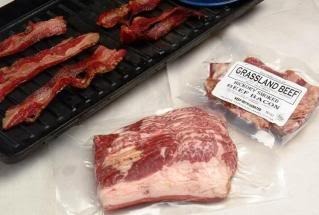 The Prize:
The Prize:
A Bacon Bonanza prize package from U.S. Wellness which is comprised of all this bacony goodness:
Beef Bacon
Sugar Free Beef Bacon
Beef Bacon Tips
Sugar Free Beef Bacon Tips
Sugar Free Pork Bacon
Sugar Free Pork Bacon Ends



The Contest:
Today’s contest is so easy a caveman could… it’s super easy. Visit U.S. Wellness here and sign up for their newsletter. In addition to special discounts, meaty recipes and updates on this family farm, you’ll be entered to win the Bacon Bonanza prize above.
While there can only be one Bacon Bonanza winner, you can still acquire some of your own by visting U.S. Wellness online. And don’t forget to check out U.S. Wellness on Facebook and YouTube.
Eligibility:
Only U.S. residents are eligible.
The Contest End Time:
October 6, midnight, PDT.
How the Winner Will Be Determined:
A winner will be chosen at random from those that subscribe during this contest period, and emailed to arrange for delivery.
To track all the contests visit the 2013 Primal Blueprint 21-Day Challenge Contest Page for daily updates.
Order The Primal Blueprint Starter Kit and Take Control of Your Health Today!

September 28, 2013
Sausage and Eggs to Go
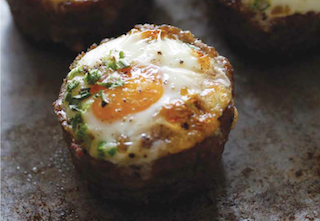 The following recipe is pulled straight from the pages of the new Primal Blueprint Publishing publication Primal Cravings. Authors Brand and Megan Keatley really know how make delicious Primal dishes, and often with surprisingly few ingredients. This recipe doesn’t disappoint on both counts. Start day 13 of your 21 day challenge off right and give this recipe a try today. Now, enter Brandon and Megan…
The following recipe is pulled straight from the pages of the new Primal Blueprint Publishing publication Primal Cravings. Authors Brand and Megan Keatley really know how make delicious Primal dishes, and often with surprisingly few ingredients. This recipe doesn’t disappoint on both counts. Start day 13 of your 21 day challenge off right and give this recipe a try today. Now, enter Brandon and Megan…
A big problem with making a good go at Primal eating is breakfast. The reason is twofold. One, we’re all so used to standard American breakfast fare of the last 30 years (processed carbs and sugar, think: cereal, bagels, pastries, juice) and two, it’s early and you have a job or class or something to get to, who has time to cook?
We’ve got a recipe that’s really helped people to solve both of those problems. Our Sausage and Eggs to Go is a delicious, convenient, and most importantly portable option for Primal breakfast. These can be made ahead of time and reheat really well, which is difficult to do with other egg recipes. Try them plain or with some yellow mustard.
A solid recipe as-is. You could also use this recipe as a base for endless variations. Try sautéing mushrooms and onions or bell peppers and ham, then adding them into whisked eggs.
Serves: 6
Ingredients:
1 pound Breakfast Sausage (from page 264 if you own a copy of the book, or store bought)
6 eggs
1 green onion, sliced
Salt to taste
Instructions:
Preheat oven to 350°F.
Divide the sausage into 6 portions, and place each into its own individual ramekin. Use your hands to push the sausage around the bottom and up the sides of the ramekin, creating a “crust” for the egg to bake in.
Crack an egg into each sausage crust. For a scrambled variation, whisk the eggs before pouring in.
Top with a sprinkle of salt and a few slices of green onion.
Bake until the eggs are set, about 30 minutes.

Not Sure What to Eat? Get the Primal Blueprint Meal Plan for Shopping Lists and Recipes Delivered Directly to Your Inbox Each Week

Contest: Prizes for Your Thoughts
The Prize:
 Squatty Potty – You think Grok took a seat on a porcelain throne when nature called? Of course not! Toilets are modern inventions. Grok squatted, and so should you. Why? Well, squatting opens up the colon for fast and easy elimination, which is said to relieve constipation, straining issues, hemorrhoids, bloating and more. But what are we to do? Is it time for all-out bathroom renovations? No, there’s a simpler solution, and that’s where Squatty Potty comes to the rescue. Watch the video below to learn what a Squatty Potty is and win one today by participating in this contest!
Squatty Potty – You think Grok took a seat on a porcelain throne when nature called? Of course not! Toilets are modern inventions. Grok squatted, and so should you. Why? Well, squatting opens up the colon for fast and easy elimination, which is said to relieve constipation, straining issues, hemorrhoids, bloating and more. But what are we to do? Is it time for all-out bathroom renovations? No, there’s a simpler solution, and that’s where Squatty Potty comes to the rescue. Watch the video below to learn what a Squatty Potty is and win one today by participating in this contest!
The first 50 participants of this contest will get a free Squatty Ecco.
BONUS: Use coupon code mda20 at checkout and get 20% off your order through October 31.
 The Primal Blueprint Platinum Package – The Platinum Package is the ultimate in supplementation and is what thousands of Primal enthusiasts and I take daily. It includes: Damage Control Master Formula, Primal Fuel, Primal Flora, Vital Omegas, and Vitamin D booster.
The Primal Blueprint Platinum Package – The Platinum Package is the ultimate in supplementation and is what thousands of Primal enthusiasts and I take daily. It includes: Damage Control Master Formula, Primal Fuel, Primal Flora, Vital Omegas, and Vitamin D booster.
One randomly selected participant will win a Platinum Package.
The Contest:
This one’s simple. If you’ve used any of the Primal Blueprint supplements I’d love to hear from you. Has Primal Fuel helped you eliminate sugar cravings and lose body fat? Has Primal Flora helped to improve your digestion and regularity? Did you reverse a vitamin D deficiency with Primal Blueprint Vitamin D?
Tell me about it by filling out this form.
I get success story emails every day, but I never tire of hearing how the Primal Blueprint family of supplements (books, events and services) have helped people take control of their health and change their lives.
Eligibility:
Only U.S. residents for this one.
The Contest End Time:
October 2, midnight PDT.
How the Winner Will Be Determined:
The first 50 participants get a Squatty Potty. One randomly selected winner gets a Platinum Package.
To track all the contests visit the 2013 Primal Blueprint 21-Day Challenge Contest Page for daily updates.
Order The Primal Blueprint Starter Kit and Take Control of Your Health Today!

September 27, 2013
The Primal Lifestyle Helped Me Achieve My Dreams
It’s Friday, everyone! And that means another Primal Blueprint Real Life Story from a Mark’s Daily Apple reader. If you have your own success story and would like to share it with me and the Mark’s Daily Apple community please contact me here. I’ll continue to publish these each Friday as long as they keep coming in. Thank you for reading!
 We all know that following your dreams means hard work, dedication, follow through, and determination. But how important is what you eat in determining your chances of failing or succeeding in your life ambitions? Eating Primally has proven to be an integral part of my quest to live out my dreams. Here is my story.
We all know that following your dreams means hard work, dedication, follow through, and determination. But how important is what you eat in determining your chances of failing or succeeding in your life ambitions? Eating Primally has proven to be an integral part of my quest to live out my dreams. Here is my story.
Even from a young age, I’ve always been very conscientious about my food choices. I decided to stop eating red meat when I was 12 years old. It was a decision I made based on something I had read about slaughterhouses. I eventually transitioned into a full-blown vegetarian. My mom followed suit and we primarily lived off veggie burgers and salads during my teen years. Oh yeah, and popcorn was a big staple in our house, with fat free “butter” sprayed all over it. I read Fit For Life when I was a senior in high school and started practicing food combining and maintained that practice for a few years. Looking back, I cannot remember a time when I did not have some “diet” or eating strategy I was trying on for size. I wouldn’t have declared myself someone who had an eating disorder, but food and exercise consumed a considerable amount of space in my mental hard drive. When would my next meal be? What would I eat? Would I binge on something that I knew wasn’t good for me and feel bad about myself ? Would I work out extra hard to help offset the extra calories, or would I have the mental fortitude to avoid the “bad food” and eat something “healthy” like a whole grain pizza with extra vegetables? No matter which decision I made, I inevitably came right back to thinking about my next meal. I assumed the incessant chatter that went on in my mind was a side effect of my health conscious outlook. Most of the other women I knew had the same affliction and we just accepted it as the norm.
I don’t regret trying all the various dieting strategies. It was an important part of my journey and it helped me learn a lot about myself and what actually works for me. I still enjoy tweaking the way I eat, sleep, and train, and enjoy experimenting on myself regularly. This isn’t to say that early experiments went over so well…
Eating a high-grain low-fat diet was causing a host of issues, including an increase in seasonal allergies, acne problems, and constant digestion trouble. In 2006, when I started training with Robb Wolf, I had already eliminated gluten and most grains and realized that adding animal protein to my diet was in my best interest. I was feeling better, but had yet to go completely paleo. Over the course of the next several years I transitioned to a strict paleo diet, and the most interesting side effect took place. I stopped obsessing over food. I didn’t notice it right away, but it struck me one day. I could completely lose myself in whatever task was at hand without the nagging voice in the back of my head reminding me to think about food. This was a remarkably freeing time in my life. I found that my creative side intensified and my energy levels skyrocketed. I believe this enabled me to start using my mental faculties to focus on things I wanted to accomplish, dreams I wanted to achieve. I realized that I had been putting off so many things because I just couldn’t imagine adding one more thing to my list of to do’s. I was already juggling life, career, school, and family. How could there possibly be room for my dreams!
It seems like a small thing, but I really believe that living a more Primal lifestyle gave me the energy and the mental stamina to start tackling all of my aspirations. One of which was to make a go at my ambition to be a musician. Another of which was to take my experience working with Robb Wolf and my passion for the paleo lifestyle and turn it into a career. Over the next several years I made a host of bold moves and my Primal lifestyle helped me along. I no longer had to dedicate hours to the gym everyday or worry about meals. I could use my time to write music, record and perform.
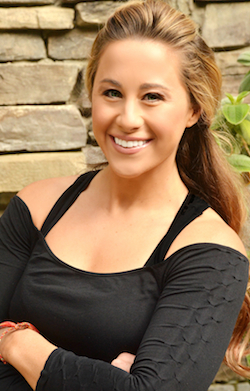 After a stint of living in Nashville and recording my first album, I moved back to California to Los Angeles. This is when I saw a job opening at Primal Nutrition and knew it was the perfect opportunity to do something I love. I met with Mark and his team and the rest is history. I’ve been part of the team myself for several years now. Many of you may know me from PrimalCon where my husband Adam Lambert and I coach on strength training. I’m also involved in Personal Coaching and the Luxury Retreats, and I’ve been able to do all this while pursuing my career in music. Both careers are extremely consuming and extremely gratifying, and I’m convinced I never could have done it without the Primal lifestyle.
After a stint of living in Nashville and recording my first album, I moved back to California to Los Angeles. This is when I saw a job opening at Primal Nutrition and knew it was the perfect opportunity to do something I love. I met with Mark and his team and the rest is history. I’ve been part of the team myself for several years now. Many of you may know me from PrimalCon where my husband Adam Lambert and I coach on strength training. I’m also involved in Personal Coaching and the Luxury Retreats, and I’ve been able to do all this while pursuing my career in music. Both careers are extremely consuming and extremely gratifying, and I’m convinced I never could have done it without the Primal lifestyle.
I just want to thank Mark for not only being a great mentor and boss, but a great friend and someone I truly respect and admire. It has been wonderful being part of the Primal team and none of this would have been possible had he not dared to share his dream and passion with all of us.
Vanessa
P.S. For anyone who would like to check out my new album, or learn more about my musical alter ego Nesta!, here are some links. Grok on!
My new album on iTunes: Levitate
The single Stay on iTunes
The official music video for Stay on YouTube
NestaTunes.com, YouTube, Facebook, Twitter, Instagram, Pinterest
Order The Primal Blueprint Starter Kit and Take Control of Your Health Today!

Contest: Be Featured in the Upcoming Book The Primal Teen
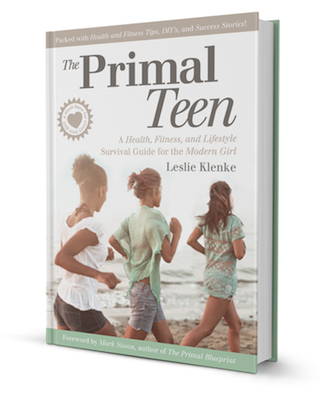 When you guys ask, I certainly try my very best to deliver. Within the Primal community there’s been a growing demand for information about the differences between being a Primal man and woman, like the effects of fasting, battling cellulite, and dealing with menopause. As many of you know, my wife Carrie began her research on the topic and we are eagerly bringing you Primal Woman mid-next year.
When you guys ask, I certainly try my very best to deliver. Within the Primal community there’s been a growing demand for information about the differences between being a Primal man and woman, like the effects of fasting, battling cellulite, and dealing with menopause. As many of you know, my wife Carrie began her research on the topic and we are eagerly bringing you Primal Woman mid-next year.
However, is there another group of individuals I’ve left out? What about teenagers? I’m sure you all remember growing up and dealing with new hormones, peer pressure, and the opposite sex. Heck, if you can’t remember that far back, you probably have some youngsters of your own going through these issues as we speak.
If listening to mom tell them what to eat isn’t sticking, and The Primal Blueprint is too big of an undertaking at their age, you’ll be as excited as I am about our latest addition to Primal Blueprint Publishing, The Primal Teen: A Health, Fitness, and Lifestyle Survival Guide for the Modern Girl currently being written by Leslie Klenke. (Don’t worry; she will deliver a Primal Teen for boys next, but ladies first!)
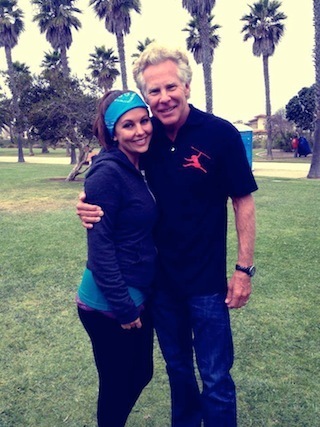 I had the pleasure of meeting Leslie at PrimalCon Oxnard back in April of this year. Shortly thereafter, she stopped by the offices in Malibu and pitched her idea for The Primal Teen. I know there is a large audience for this kind of content and trusted right away that Leslie was the right person for the job. She truly presents the information I have shared with you all in The Primal Blueprint in a voice that any teen girl will relate to. (It’s even an excellent refresher course for adults – think CliffsNotes for a woman at any age.) Leslie has left no topic uncovered: the 10 Primal Laws, meal and fitness plans, puberty, motivation, DIY recipes and beauty products, and the reason I’m coming to you today – teen success stories.
I had the pleasure of meeting Leslie at PrimalCon Oxnard back in April of this year. Shortly thereafter, she stopped by the offices in Malibu and pitched her idea for The Primal Teen. I know there is a large audience for this kind of content and trusted right away that Leslie was the right person for the job. She truly presents the information I have shared with you all in The Primal Blueprint in a voice that any teen girl will relate to. (It’s even an excellent refresher course for adults – think CliffsNotes for a woman at any age.) Leslie has left no topic uncovered: the 10 Primal Laws, meal and fitness plans, puberty, motivation, DIY recipes and beauty products, and the reason I’m coming to you today – teen success stories.
In order for Leslie to share all of your truly inspiring teen success stories, she needs a way to collect them first. When she asked me to reach out to Mark’s Daily Apple readers, I was more than happy to share her request and get your Primal teenage daughters involved in this project. Whether your daughter has been Primal alongside you since you started or if she’s just now getting her toes wet, this could be her opportunity to get published and share her story with millions of other teens facing the same challenges.
The Prize:
Fame, riches, notoriety. Kidding, of course. But this is your chance to be featured in the upcoming book The Primal Teen. Share your story with thousands of other teens so they can learn from what you’ve already accomplished. This is an opportunity to change lives and help people. I’d say that’s prize enough, but hey, you’ll get free copies of the book for friends and family, too, of course!
You’ll also be entered to win the regular Share You Success Story contest prize package: 2 PaleoKrunch Samplers, 2 Steve’s Club Samplers, 2 Seasonal Samplers, 2 PaleoChef Samplers, 2 Sauce Samplers, a 10 meter Blackthorn Battle Rope, a Blackthorn Sling Trainer, Nick’s Grass-Fed Beef Sticks, and a Primal Essentials Kit.
The Contest:
Share your Primal teen success story by filling out this form.
Eligibility:
You must be a teen (between 13-19 years old), and a girl. No middle aged guys dressed in a wig and makeup.
The Deadline:
October 7, midnight PDT. Less than two weeks away!
How the Winners Will Be Determined:
Leslie, myself and the Primal Blueprint Publishing team will choose select stories to be featured in the book.
To track all the contests visit the 2013 Primal Blueprint 21-Day Challenge Contest Page for daily updates.
Order The Primal Blueprint Starter Kit and Take Control of Your Health Today!

September 26, 2013
Midpoint Check-In: The Power of Community (Plus a Simple Comment Contest)
 With all the action around here, it’s amazing to me we’re already at the midpoint of the 21-Day Challenge! The flood of feedback, comments and contest participation has been awesome, and it’s all a reminder of how great a community this is. It never ceases to amaze me actually just how positive a group we have. Seriously, in all the blogosphere, I’ve never stumbled upon anything like it, and I have people tell me as much all the time. Sure, the growth and engagement that all the web number crunchers measure are stellar, but I’m talking deeper than that. I mean the genuine support that is shared here.
With all the action around here, it’s amazing to me we’re already at the midpoint of the 21-Day Challenge! The flood of feedback, comments and contest participation has been awesome, and it’s all a reminder of how great a community this is. It never ceases to amaze me actually just how positive a group we have. Seriously, in all the blogosphere, I’ve never stumbled upon anything like it, and I have people tell me as much all the time. Sure, the growth and engagement that all the web number crunchers measure are stellar, but I’m talking deeper than that. I mean the genuine support that is shared here.
From day one of this blog (hands for how many of you were with us way back in 2006!), it’s been the case. People want to help people. There’s great conversation and healthy challenge on the boards, but the spirit of exchange is impressively constructive. Readers themselves have told me how much that collective energy impacts them – how they’ve tapped into it to get them through rough patches or to help motivate them toward bigger visions of thriving and transformation.
The fact is, it’s all too easy to isolate and live with the misguided view that we have to do it all alone – that we should do it all independently. Sure, maybe some of us can conceivably get to our goal without the support, guidance, sharing, etc. But why would we? What are we trying to prove to ourselves? Some people find it noble, but I think it’s just unnecessary. There’s something small and surrendered about the self-contained approach. The fact is, when you open yourself and your process to others, your view of that process and your vision of what’s possible become more expansive.
Likewise, when you’re feeling discouraged because of a setback or crisis of confidence, others can hold that promise for you. They can be the mirror for you. You may not be able to envision great progress on certain days, but seeing it in others – and imagining it for others as you encourage fellow readers on their paths – makes your own possibility of success feel less remote. A community holds optimism – and wisdom – collectively.
On that note, how goes the journey? What is everyone up to – trying, cooking, lifting, feeling, enjoying etc.? I want to encourage each and every one of you out there to interact today (and every day would be cool, too) on the comment board. In fact, it’s the focus of today’s Contest….
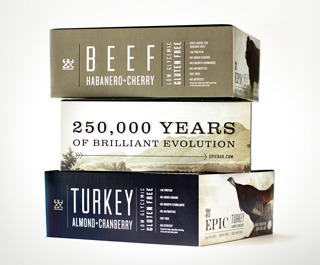 The Prize:
The Prize:
The EPIC bar is a 100% grass fed animal based protein bar. It’s paleo friendly, gluten free, and low in sugar. The names of their bars alone leave the mouth watering: How about a Bison Bacon Cranberry bar, a Beef Habanero Cherry bar, or a Turkey Almond Cranberry bar? Yes, please. To all three, thank you very much.
Catch EPIC bar on Facebook.
The lucky winner of this contest will win 3 boxes of EPIC bars plus an EPIC bar t-shirt. Retail value: $125.
BONUS: Use the code EPICHEARTSMARK at EpicBar.com and get free shipping on your order. Valid for five days.
The Contest:
Leave a comment on the board about what you’ve struggled with lately in the Challenge, and/or give your advice to others. Share your anecdotes, stumbles, questions and successes. Share the totally random and nagging craving you’re having, the annoying vestiges of low-carb flu, the odd sleep disturbances or dream patterns (not unheard of), the strangest comments you’ve gotten from various people, the hardest part in the process so far.
Likewise, offer your suggestions and encouragement to others. What strategies did you use to kick cravings? How did you motivate yourself to exercise on days you were tired and it was raining buckets outside? What did you tell naysayers that seemed to get them off your back? If another reader has a struggle or a question and you have an answer–go for it! A winner will be randomly selected from all the comments.
So, there you go! Throw in your questions and responses, and see the support of the MDA community at full throttle! I’m looking forward to reading how everyone is doing and what comes of all the great community feedback. Thanks for stopping in today, everybody. Here’s to an even more amazing and successful second half of the Challenge!
The Deadline:
September 26, midnight PDT.
Who is Eligible:
U.S. residents only for this one. Sorry international readers!
How the Winner Will Be Determined:
A winner will be randomly selected.
Order The Primal Blueprint Starter Kit and Take Control of Your Health Today!

September 25, 2013
The 10 Habits of Highly Successful Hunter-Gatherers
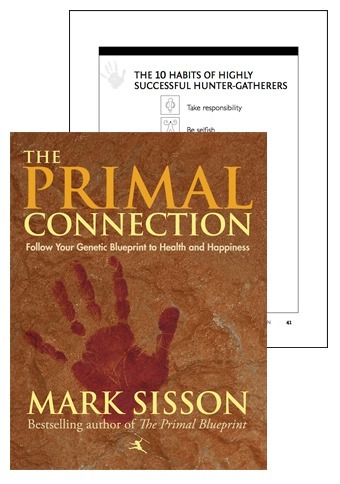 While the Challenge centers on those critical basics of good Primal health – food, exercise, sun, sleep, and play – there’s more to Primal life than just what I’d call the essentials (yes, play is an essential). The essentials offer us the optimum chance at health and general contentment. In looking (and living) beyond these basics, however, I think we find something critical. It’s the key to the questions about how to further apply Primal principles in a world that is anything but. We think we have it all down. It’s easy. Got it! Then the rest of our surrounding civilization has its say, disturbs our Primal peace, intrudes upon our confidence, throws its chaos in our well-intentioned plans. The answer isn’t to scrap the whole project but to deepen the lesson.
While the Challenge centers on those critical basics of good Primal health – food, exercise, sun, sleep, and play – there’s more to Primal life than just what I’d call the essentials (yes, play is an essential). The essentials offer us the optimum chance at health and general contentment. In looking (and living) beyond these basics, however, I think we find something critical. It’s the key to the questions about how to further apply Primal principles in a world that is anything but. We think we have it all down. It’s easy. Got it! Then the rest of our surrounding civilization has its say, disturbs our Primal peace, intrudes upon our confidence, throws its chaos in our well-intentioned plans. The answer isn’t to scrap the whole project but to deepen the lesson.
Let me expand a bit by talking about a topic that might be familiar to many of you – the “habits of successful hunter-gatherers.” They’re the cornerstones of a larger vision for ancestrally inspired living, The Primal Connection. If we can learn from our forebears’ diets and activities, what wisdom can we garner or extrapolate from other elements of their living conditions – for example, their social structures and cultural patterns. Here are all ten habits – presented for the first time on MDA and repurposed for the Challenge.
Forget about whatever else you’re doing or surrounded by for a moment. Think. Imagine. What would it have taken to be a highly successful hunter-gatherer? Brawn? Speed? Good aim? Stamina? Carving skills? A sharp eye or memory? Of course. But what about those less obvious attributes like creativity, empathy, intuition, even-temper, mettle, compassion, cool-headedness? After all, all the strength in the world won’t match a good weapon in many situations. A lone wolf will always be more vulnerable on the savanna than his connected counterparts. An easygoing perspective can make living with others easier. Equanimity keeps emotional responses in check and critical focus on the present. Grit can mean the difference between life and death.
If the hard knocks of evolutionary history cultivated these types of pivotal traits in our ancestors, how do we reconnect with – and benefit from – them today? It’s an intriguing and productive question for life in general, but I think it has special significance for the Challenge. What better self-development project can there be than fostering the habits of highly successful hunter-gatherers? What could it mean, for example, for our daily lives? For our relationships? For our mental health, emotional resilience and general satisfaction? How could contemplating these habits – and applying them – affect your experience of the Challenge?
In addition to reconnecting with our natural environments, rhythms, and biomechanics, it’s impossible to discount the relevance of these more cognitive and cultural Primal “habits.” Sure, it’s the stuff that can’t be nailed down. When it comes to our ancestors’ neurological trajectories, we have the likes of skull proportions and tool complexity to compare. Beyond that, the specifics get dicey. Grok and his kin left no diaries or personal blogs. The more intimate details of their lives will never be known, as much as we might like to imagine their stories. Nonetheless, we can extrapolate from the conditions in which, we theorize, our ancestors lived and then target what skills and perspectives those environments would’ve favored for survival. (The observations of traditional societies living today add to this picture in their own partial way, but that’s fodder for another discussion.)
The idea here isn’t an academic model. Yet, it’s not tongue-in-cheek either. What we’re after, of course, is a practical point of reference for the everyday person who wants to enjoy life for all the fulfillment, happiness, and peace that he or she can find in it. There’s something to speculating about Grok’s angle on life and what we can safely assume was a striking contrast to the modern mindset that too often breeds stress, disengagement, and impatience. What’s to be gained from the perspective of Grok, our resident highly successful hunter-gatherer? Consider his evolutionary context a touchstone we can use to gauge our own sense of balance. The “10 Habits” are finally a reminder to question cultural scripts in pursuit of something more timeless and fundamental in our individual lives. The Habits challenge us to scrutinize how much we organize our lives around modern norms, which may be “normal” but not productive for us. Ultimately, perhaps, they give us license to imagine – design for ourselves, really – an ancestrally-informed point of homeostasis to thrive within each day.
Habit #1: Take Responsibility
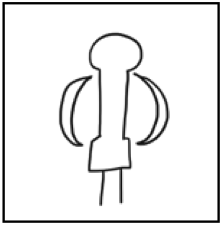 In the era of our Primal ancestors, there was little room for finger pointing after the fact, little patience for runaway blame, little chance to avoid the direct consequences of their choices. The stakes were higher. The potential ramifications more dire. In issues of life and death, belonging or banishment, you didn’t want to tempt fate with much carelessness, much thoughtlessness or much self-pity. The easier you were to get along with and the more accepting you were of basic accountability in the here and now, the more likely you were to see tomorrow.
In the era of our Primal ancestors, there was little room for finger pointing after the fact, little patience for runaway blame, little chance to avoid the direct consequences of their choices. The stakes were higher. The potential ramifications more dire. In issues of life and death, belonging or banishment, you didn’t want to tempt fate with much carelessness, much thoughtlessness or much self-pity. The easier you were to get along with and the more accepting you were of basic accountability in the here and now, the more likely you were to see tomorrow.
Taking responsibility obliges us to scrutinize our own complicity in our life’s difficulties, in the bad decisions, in the less-than-ideal circumstances. When we think about our health, our professional lives, our relationships or any other area where grievances live, what have we done/are we doing to perpetuate a miserable pattern? How have we conspired with the negative influences to get us where we’re at? Why do we continue to accept situations that genuinely don’t work for us?
That said, it’s not about chastising ourselves. Taking responsibility for our lives doesn’t call us to emotionally beat ourselves up. It doesn’t oblige us to lash ourselves for past mistakes. I think that approach is in its own way a skirting of and distraction from real responsibility. Punishment (whether inflicted by oneself or another) doesn’t leave genuine room for responsibility; it holds the process hostage – and the people (or single person) caught in its distorting lair.
Maybe we really did get a raw deal – in childhood, in the job market, in our first marriage, in that bout with cancer. Taking responsibility doesn’t mean forgetting the past or turning over all awareness of the difficulties we’ve faced. I think it’s more a question of owning our lives – for all their mixed circumstances. We put ourselves in right orientation with our responsibility – taking what’s ours (and, importantly, giving back what’s not ours – letting others have the dignity as well as consequences of their own authority).
When you stop distracting yourself with what belongs to other people, you can focus on your own life. When you own where you’re at in said life, you’re empowered to move forward in it. When you place power in your life elsewhere (e.g. other people, a work place, etc.), however, you’ve chosen to relinquish that power. You’ve given it away.
True, we can’t control every medical event. We can’t legislate others’ actions or responses to our choices. Yet, we can accept the basic circumstances and commit to driving our lives forward from that point rather than staying stuck in a place of regret and longing.
The fact is, bitterness breeds inertia. Blaming allows us to languish in the comfort of bad habits. It encourages us, in fact, to stay stuck smack dab in that lulling space of woe-is-me martyrdom. In that way, blame will betray us every time. Victimhood blocks any chance at greater vision. Excuses stand in for action. The result, we spend life in a stifling cul-de-sac.
Habit #2: Be Selfish
 In our ancestors’ day, there was certainly a sense of obligation to the group, an expectation of contribution to the joint welfare. That said, in an economy of ample free time, a social network of extended kin, a culture nearly devoid of material ambition, no one was likely required or motivated to drive themselves to exhaustion.
In our ancestors’ day, there was certainly a sense of obligation to the group, an expectation of contribution to the joint welfare. That said, in an economy of ample free time, a social network of extended kin, a culture nearly devoid of material ambition, no one was likely required or motivated to drive themselves to exhaustion.
I believe the “pack mule” mentality is a thoroughly modern neurosis. Why would any single person in a band ever accept grossly inordinate proportions of responsibility in our Primal ancestors’ time? With all members free to leave at any time in the natural ebb and flow of band to band interchange, why would any of them lived a wretched life of literal or approximated servitude? If you ran yourself into the ground healthwise in evolutionary times, you put yourself at risk. You were a liability to the group. What was the possible benefit?
Yet, here we are in modern times making excuses for neglecting our health, giving away the chance (and true responsibility) for reasonable self-care and personal fulfillment. Part of the logic is the modern focus on the future. We’re planners, sacrificers for the sake of a presumed future security. It’s amazing what we’ll give up in the interest of a vision twenty years out. The result? We live in a kind of chronic self-debt. We’re seeking to serve ourselves, but we’re distorted in the extremeness of the terms.
This flies in the face of our ancestors’ culture of immediacy. There’s something to that living in the here and now rather than for the sometime-down-the-road. I think it’s possible to balance the two for the benefit of both, but it’s a deal with the devil to think we can continually neglect ourselves for the people and projected future of our lives. Our sense of balance must demand current and continual well-being for ourselves. When we are nourished and sustained today, we have more to offer to those around us and to our futures.
Habit #3: Build a Tribe
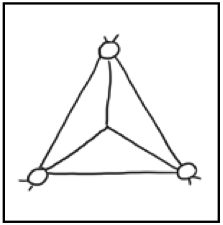 Our ancestors depended upon a tight knit social circle. Their survival hinged upon it, in fact. The band community of 25-50 people was forged within a sense of mutuality – action for the good of the group. It was more than simple transaction, larger than familial connection (not everyone was related). You became kin by being kin and sharing in the menial work, the ongoing stories, and the meaningful celebrations of the band.
Our ancestors depended upon a tight knit social circle. Their survival hinged upon it, in fact. The band community of 25-50 people was forged within a sense of mutuality – action for the good of the group. It was more than simple transaction, larger than familial connection (not everyone was related). You became kin by being kin and sharing in the menial work, the ongoing stories, and the meaningful celebrations of the band.
In this day and age, we live in proximity to numbers that would’ve stunned our ancestors. We count our social media “friends” into the hundreds, but we often miss a sense of close, constant connection. Exposure doesn’t fill our social wells. Neither do status updates.
These days we can go through our adult lives with few, if any, intimate relationships – the kind of connections that feel like kin – our own tribe. You’ve seen each other through transitions, successes, and disappointments. You have history and your own stories. The fact is, we haven’t outgrown or out-evolved the need for kin. We live with the same genes that benefited from social connection and the same biochemistry that rewards it. With frequent relocations and busy lives, connecting gets complicated. Too many of us end up socially adrift.
If you find yourself at this point in your life without a core group, build one. Don’t make the excuse that you just missed the boat. It’s just too important. You’ll be glad you didn’t later. Feed this “highly successful” habit by first deepening the relationships you already have. When you begin seeing your partner, family members, kids, and closer friends as your tribe, you gain a whole new level of appreciation for the role they play in your life. Reconnect with old friends, and test the waters to see if there’s potential there to become close again. Get out into the world, meet people, and make an invitation. Invite a coworker for lunch. Join a book group or basketball league. Start a volunteer team at your house of worship or place of work. Create a Meetup group. Host an open house for the neighbors. Over time, cultivate the relationships that seem most genuine and promising. Cultivate that mutuality in small but significant ways. Bring your best to the friendship and expect the same in return.
Habit #4: Be Present
 We can all do a self-inventory now of the attention we give our phones or other technological devices. We can confess to ourselves how much we let residual work infiltrate our personal lives. Don’t forget what I think is one of our biggest trip-ups in modern living: the penchant for mental chatter. Truth be told, how much time do we spend caught up in replaying a conversation from the previous evening, imagining multiple stressful scenarios that might take place when we confront a certain person about x, y, and z, worrying about what other people think of our outfit or hair today? Let’s face it, our modern disconnect is rampant distraction.
We can all do a self-inventory now of the attention we give our phones or other technological devices. We can confess to ourselves how much we let residual work infiltrate our personal lives. Don’t forget what I think is one of our biggest trip-ups in modern living: the penchant for mental chatter. Truth be told, how much time do we spend caught up in replaying a conversation from the previous evening, imagining multiple stressful scenarios that might take place when we confront a certain person about x, y, and z, worrying about what other people think of our outfit or hair today? Let’s face it, our modern disconnect is rampant distraction.
Can you imagine if Grok walked across the savanna perpetually lost in thought about his latest wardrobe experiment? (As if he ever saw his reflection anyway…) He wouldn’t last long enough for it to matter. For our ancestors, life was an exercise in continual hyper-vigilance. Not every second, but close. It wasn’t just the risk of becoming another creature’s dinner either. Attentiveness also meant watching for weather, catching migratory patterns, and deciphering water sources – just to name a few examples.
The Primal Connection is to be found in giving the moment your full attention. It’s about minding the difference between thoughtful deliberation or reflection and so-called monkey brain. It’s about throwing off the strangling self-absorption we trap ourselves in every day standing in line with our phones or with our mental chatter. See the people, places, and possibilities in front of you. Feed this “highly successful” habit by observing your loved ones – all the changes and uniqueness that’s right there to be appreciated. Go on a walk with the goal of finding at least a dozen things you’ve never noticed. Use mindfulness check-ins to remember to come down from the mental busyness and come back to center throughout the day.
Habit #5: Be Curious
 The thing about us hominids, is this. We think. We imagine. We create. We explore. We experiment and extrapolate. We’re driven to go around yet another corner of the path. We’ll push the envelope continually because it feels good to do it. It’s how we got ahead in the evolutionary game, how we’re so vastly successful after all. The wheel didn’t invent itself. Neither did all the continents come knocking at the door of the African savannah. You get the point.
The thing about us hominids, is this. We think. We imagine. We create. We explore. We experiment and extrapolate. We’re driven to go around yet another corner of the path. We’ll push the envelope continually because it feels good to do it. It’s how we got ahead in the evolutionary game, how we’re so vastly successful after all. The wheel didn’t invent itself. Neither did all the continents come knocking at the door of the African savannah. You get the point.
Fast forward to today, and we’re a tale of contradiction. As a species we’ve advanced to the outer edges of the solar system. As individuals, however, our daily lives might not appear so inspiring. The thing is, we’re so ungodly busy. We’ve got filled calendars, packed schedules, pocket-sized devices and big screen distractions to keep us occupied and then some.
In the midst of running errands, doing chores, working our hours and keeping up with Facebook, we’re pretty much spent. We’re caught in the day-to-day grind and can’t find a way out. We get stuck in the details. Life becomes a task rather than a discovery. We’re wasting our own hard-won evolutionary gifts in service of – what was it supposed to be?
It’s important to allow yourself your full humanity – to cultivate it, to give it air on a frequent basis. That’s exactly how it is with curiosity. It’s not so much another to-do. It’s more a force that will operate when you you let it. It’s necessary, however, to clear out the mental and logistical clutter that keep it buried, stagnant. The more spaciousness we allow in our lives, the more freely curiosity can operate in our lives.
So many of us have overloaded ourselves for so long, we’ve forgotten what even interests us, what we have a passion for, what piques our curiosity. I’m not talking spontaneous clicks on an Internet “best dressed” list for the latest awards ceremony or the (legitimately entertaining but fleeting) interest in what will happen in the final episode of Breaking Bad. I’m talking about the enriching hobbies, the life passions, the exploratory big questions that draw us in. I’m talking about the grand inquiries that help drive or define our lives. Stop for a minute: do you have any? There’s where to start.
Habit #6: Trust Your Gut
 Gut instinct, as modern science understands, is really an interworking within the neural network, a rapid reasoning that absorbs and processes both distinct and subtle cues in the environment. When we don’t feel right about a person or a decision or even the call to make a decision in the moment, we can trust the neuro-hormonal production and communication that are taking place. Our guts get the message before our brains can register the input. Modern culture, however, is often so fixated on extolling the virtues of civilized progress, we unconsciously disown the benefits of our basic humanity. Trusting our gut is part of reclaiming those.
Gut instinct, as modern science understands, is really an interworking within the neural network, a rapid reasoning that absorbs and processes both distinct and subtle cues in the environment. When we don’t feel right about a person or a decision or even the call to make a decision in the moment, we can trust the neuro-hormonal production and communication that are taking place. Our guts get the message before our brains can register the input. Modern culture, however, is often so fixated on extolling the virtues of civilized progress, we unconsciously disown the benefits of our basic humanity. Trusting our gut is part of reclaiming those.
It’s pretty easy to see how this ability would’ve been critically adaptive to our ancestors. In their worlds, it was the difference between life and death – whether in the middle of a hunt or in the middle of escaping being hunted or navigating the landscape for routes and water sources.
Tapping into the fine-drawn distinctions in our environments is kind of a lost skill. We live with overwhelment, even chaos compared to our ancestors. The noise, the crowds, the rush that runs past us visually in a day. We’re more skilled at the rather necessary survival strategy (for mental health at least) of tuning out rather than tuning in.
That said, we do carry the same genes, the same inherent abilities to tap into the telling but understated detail of our environment (and each other). When we feel this again, use it and strengthen it like a neglected muscle, we also become more in touch with our own gut sense. There’s something decidedly Primal about the philosophies that say we find self-awareness and “awake-ness” in true silence.
Sure, it helps to get out of the big, brash cacophony of our modern environments but even more so the rushing, jangling story lines and scenarios we have running like movie reels in our heads 24-7 instead of being in the moment we’re actually in. Turn off the projector and simply be, be aware, be of and in your environment (the more natural the better). Whether it’s extended time in wilderness or even a mindfulness meditation practice, get in touch with that non-cerebral, pre-symbolic gut sense again. Let it become a guiding compass again.
Habit #7: Pick Your Battles
 This is just a basic conservation principle – essential to nature. To our ancestors, life was a continual process of cost-benefit analysis. Was there something substantial to be gained from an extra effort, risk or conflict? Was a particular endeavor worth upsetting the equilibrium? Forty thousand years ago, there was less room for error in most situations, after all.
This is just a basic conservation principle – essential to nature. To our ancestors, life was a continual process of cost-benefit analysis. Was there something substantial to be gained from an extra effort, risk or conflict? Was a particular endeavor worth upsetting the equilibrium? Forty thousand years ago, there was less room for error in most situations, after all.
The same lesson holds today. Ask yourself where your energy goes. Ask yourself what amount of risk you take, what amount of conflict you generate or accept in your life? Is it worth it? This doesn’t mean nothing is worth a risk or nothing is worth fighting for. It’s simply a recognition that your time, energy and other resources are limited. At a midlife inventory or, worse yet, the end of life, will you feel you pursued the right relationships and endeavors and let go at the right times? Were you the best person you could’ve been in those relationships? Is there a chance you’ll say to yourself, “I fought all the wrong battles”?
The larger question here is whether we have done the personal work to discern which battles are worth our time and resources. Without it, we could be wearing away the intimacy in our lives, sabotaging our professional opportunities and cutting off any chance at meaningful, enriching self-development.
Habit #8: Get Over It
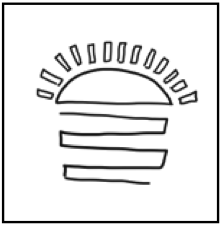 As Michael E. McCullough, author of Beyond Revenge: The Evolution of the Forgiveness Instinct, explains, the ability to forgive is as much a result of natural selection as the impulse for revenge. Forgiveness, he suggests, likely evolved as a means of social cooperation. For our ancestors, life was about conservation – of energy, of resources, of good will. In a cost-benefit analysis, nursing an unrelenting grudge would’ve been a major liability. If you couldn’t get along with the group, eventually you likely wouldn’t have been welcome anymore. Be upset, sure. But once it starts eroding the group dynamic, you’d better find yourself another band. The risk wasn’t worth the emotional indulgence.
As Michael E. McCullough, author of Beyond Revenge: The Evolution of the Forgiveness Instinct, explains, the ability to forgive is as much a result of natural selection as the impulse for revenge. Forgiveness, he suggests, likely evolved as a means of social cooperation. For our ancestors, life was about conservation – of energy, of resources, of good will. In a cost-benefit analysis, nursing an unrelenting grudge would’ve been a major liability. If you couldn’t get along with the group, eventually you likely wouldn’t have been welcome anymore. Be upset, sure. But once it starts eroding the group dynamic, you’d better find yourself another band. The risk wasn’t worth the emotional indulgence.
Although stewing ad nauseum today usually doesn’t present the critical threat of banishment, we still wallow to our own detriment. How much of ourselves do we tie up in the binds of past offenses or travails? How long will we allow ourselves to be stuck, and what are we missing out on in that time? At what point is it not even about the original sin anymore but our own circuitous, self-sustaining grief? The fact is, each day we let a past hurt, disappointment, or mistake determine our wellbeing, is a day we miss living the full measure of our potential for happiness.
A highly successful Grok type can do the (albeit modern) cost-benefit analysis and learn to let it go. What are the annoyances and resentments that we can simply release for more peace of mind? Feed the “highly successful habit” by cleaning the slate of past negativity. Use some kind of ritual if you feel it would be helpful to create a more genuine emotional closure. Keep an uncluttered emotional canvas by avoiding the minor, inconsequential conflicts that can build up for no good reason at home, among friends and family, or in the office. Learn to stop yourself when you go down that road of downer self-chatter. Cut the impending hormonal cascade in its tracks, and redirect your thoughts.
Habit #9: Sharpen Your Spear
 “Modern” humans prevailed over their Neanderthal counterparts because they were simply more adaptable. In short, they had better tools and better skills. When the going got tough, Homo sapiens sapiens had more strategy at their disposal. The rest is history.
“Modern” humans prevailed over their Neanderthal counterparts because they were simply more adaptable. In short, they had better tools and better skills. When the going got tough, Homo sapiens sapiens had more strategy at their disposal. The rest is history.
Today we earn a living with our individual skills. We get to, if we’re fortunate, have a job. We get to put food on the table and a roof over our head. For our ancestors, that was reason to be grateful and dance around a fire. We can do the same.
That said, it’s natural to want more. After so many years (or decades) in the same line of work, our specialization might offer stability and even accolades but not much inspiration anymore. For our ancestors’ part, they didn’t have the luxury of donning a single hat, limiting themselves to a specific function within the group. Everybody contributed something to just about every endeavor. In a band of 30-40 people, you wouldn’t want to turn over an essential function to a single person who at any time might be dragged away by a pack of wolves. A resistance to specializing probably has some ingrained wisdom and evolutionary merit.
Whatever stage of the game you’re at, make the investment in yourself. Pursue a new career that aligns more with your passion. Delve into a hobby that gives you genuine pleasure. Resist the modern idea that life or professional success has to follow a linear track. Define your personal trajectory in terms of your own satisfaction and sense of self-development rather than an outside template. You decide what tools and skills you’ll hone and the value you’ll assign to them at varying points in your life.
Habit #10: Be Affluent
 We can estimate that their daily foraging and food preparation time added up to about six hours a day. To our ancestors, the concept of affluence, if it existed, was probably very different than what we think of today. For them, the ultimate commodities were time and leisure. Funny how those were so beneficial for evolutionary progress…
We can estimate that their daily foraging and food preparation time added up to about six hours a day. To our ancestors, the concept of affluence, if it existed, was probably very different than what we think of today. For them, the ultimate commodities were time and leisure. Funny how those were so beneficial for evolutionary progress…
Compare time and leisure to what we’re encouraged to pursue and define our affluence from today – status and possessions. We often tether ourselves to them really. Even beyond the point at which our basic needs are met, the drive for accumulation and ascent takes over and can co-opt every other priority whether we even realize it or not. Sometimes we’re working so long and hard we don’t even see it creep into our consciousness. We don’t consider ourselves particularly materialistic people, let alone greedy, but somehow we get sucked into the common cultural grooves.
What does abundance mean to you? While we don’t need to swear off the blessings of modern conveniences and novelty, it’s important to define our most deep-seated priorities. What genuinely nourishes you at the physical level? What fills your intellectual, creative, social, emotional and spiritual dimensions, however you conceive of them? Too often we wind ourselves around a bloated and distorted sense of our basic needs (e.g. food, shelter and security, every knick-knack that Pottery Barn sells) all while depriving ourselves of the latter dimensions (e.g. genuine and close friends, time and outlets for self expression and development, etc.). The fact is, our basic needs are simpler than we often think. Our other, more nuanced needs, are more essential than we often think. How about embracing the idea that you get to have fulfillment on all levels? Seriously. It’s possible. What should it look like for you as an individual? That’s the real crux. Be bold enough to create a vision for your life, however counter it is to our culture’s version of success or linear progression. Think about experience and satisfaction, about playing hard and sleeping well. There’s where living abundantly begins.
Concluding Thoughts…
The central premise of The Primal Connection is that we can use the model of our ancestors to create not just a healthier physical existence but also a more balanced and fulfilling life. These are among the habits I call our inner dialogue – the assumptions, patterns, and narratives we can create or accept for ourselves. That dialogue has the power to limit or expand our lives. It will influence our potential to connect with the world and those around us. It will ultimately determine how successfully we live as modern hunter-gatherers but most importantly whether or not we will live the full measure of our Primal selves in this lifetime.
Let me know your thoughts on living as a successful hunter-gatherer and the ways these habits can affect your view of the Challenge experience. Thanks for reading, everyone!
Order The Primal Blueprint Starter Kit and Take Control of Your Health Today!

Contest: Subscribe for New eBook and Chance to Win
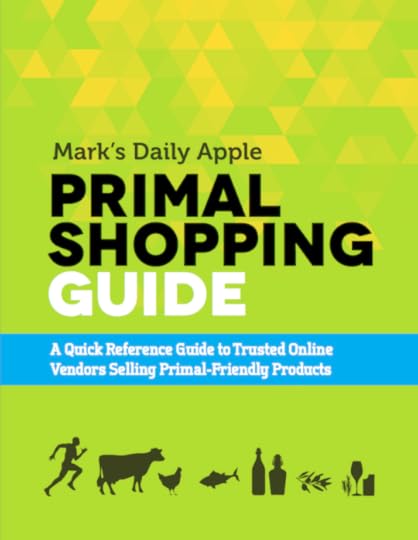
The Prize:
Have you noticed that the number of companies selling Primal-friendly products online has drastically increased in recent years? I take that to be a good thing. While a constant refrain on Mark’s Daily Apple is to eat local, eat fresh, and shop at farmers markets, and while I maintain that this is the most reliable way to get the best, most nutritious food, it’s not in the cards for everyone, nor are “local” options always enough. After all, what’s a person to do in the dead of a Minnesota winter for local grass-fed beef? How am I supposed to get local coconut oil, living in Los Angeles, when coconuts don’t grow here? Just because a food isn’t local doesn’t preclude its importance – or even necessity – in a Primal lifestyle, so thank goodness these online retailers exist. But I’ve found myself feeling a little overwhelmed with all the options. Who should I trust as my source of Primal foods that I can’t get locally? Who is the preferred online vendor of grass-fed beef jerky or organic coconut oil? I found myself wishing there was a reliable guide to online retailers selling Primal-friendly products. Since one didn’t exist, I took it upon myself to create it, and today I’m giving it away to all Mark’s Daily Apple newsletter subscribers for free.
For this eBook, the Worker Bees and I have done the hard work of vetting Primal-friendly retailers. In it you’ll find our top picks for meat, seafood, other grocery items (think jerky, coconut oil, olive oil, chocolate, nuts and the like), and fitness equipment. We also provide our favorite offerings from each of these companies, and include useful shopping tips throughout. I hope you find it useful.
Here are a couple snapshots of pages from the eBook:
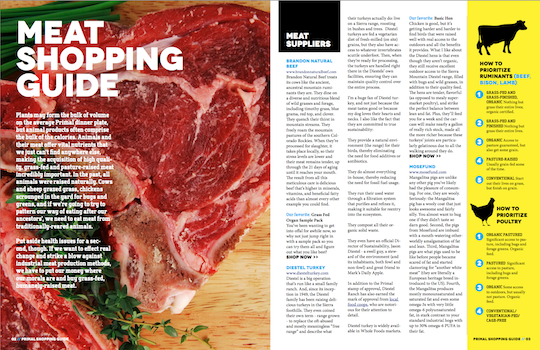
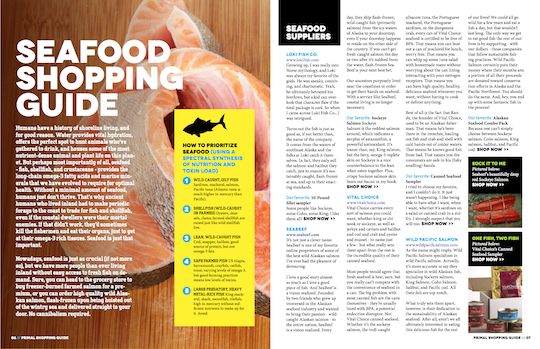
If you’re already a subscriber, you’ll receive an email today with instructions on how to access this new eBook. (Hint: It’s the same way you access all newsletter subscriber eBooks. Follow the same link and use the same access code supplied in all newsletters.)
If you aren’t yet a subscriber, what are you waiting for? Sign up using this form:
Subscribe to Mark’s Daily Apple

Name:
Email:


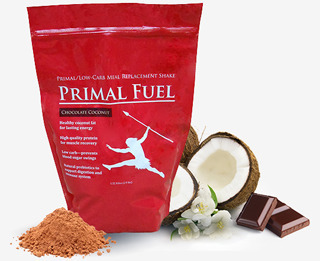 Primal Fuel – On top of everyone receiving the Primal Shopping Guide, I’m giving away a 30-day supply of Primal Fuel to one randomly selected subscriber. As most of you know, Primal Fuel is a delicious Primal shake consisting of nutritious fats from coconut milk, the gold-standard version of whey protein, just enough sugar to be tasty and Primal at the same time, and gut health-promoting prebiotics. In the three years that Primal Fuel has been available, thousands of people have tried it, and if the daily emails I receive from happy customers are any indication, nearly everyone absolutely loves it. Some prefer the delicious Vanilla Coconut Cream variety, others the decadent Chocolate Coconut. If you’re the lucky winner, you’ll get your choice.
Primal Fuel – On top of everyone receiving the Primal Shopping Guide, I’m giving away a 30-day supply of Primal Fuel to one randomly selected subscriber. As most of you know, Primal Fuel is a delicious Primal shake consisting of nutritious fats from coconut milk, the gold-standard version of whey protein, just enough sugar to be tasty and Primal at the same time, and gut health-promoting prebiotics. In the three years that Primal Fuel has been available, thousands of people have tried it, and if the daily emails I receive from happy customers are any indication, nearly everyone absolutely loves it. Some prefer the delicious Vanilla Coconut Cream variety, others the decadent Chocolate Coconut. If you’re the lucky winner, you’ll get your choice.
Eligibility:
Everyone’s eligible.
The Contest End Time:
October 2, midnight PST.
How the Winner Will Be Determined:
A winner will be randomly selected from the newsletter subscriber list.
To track all the contests visit the 2013 Primal Blueprint 21-Day Challenge Contest Page for daily updates.
Order The Primal Blueprint Starter Kit and Take Control of Your Health Today!

September 24, 2013
Cavemen Ate $12 Burgers: A Historical Perspective on Food Prices
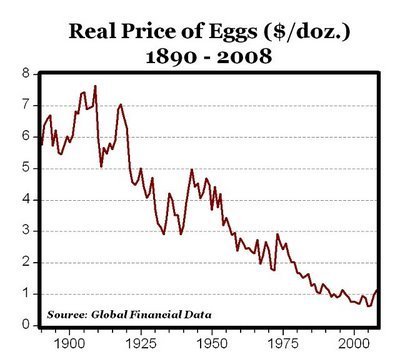 While I maintain that eating according to the Primal Blueprint doesn’t have to be expensive, it is generally true that with food – as with most other things in life – you get what you pay for. We’re one week into the 21-Day Challenge, and I imagine the cost of healthy food may be on some of your minds. So when our friend David Maren of Tendergrass Farms offered this guest article, I took him up on it.
While I maintain that eating according to the Primal Blueprint doesn’t have to be expensive, it is generally true that with food – as with most other things in life – you get what you pay for. We’re one week into the 21-Day Challenge, and I imagine the cost of healthy food may be on some of your minds. So when our friend David Maren of Tendergrass Farms offered this guest article, I took him up on it.
As a percentage of your income, how does your grocery bill compare to the grocery bills of people in different countries and eras? Are ever-lowering food costs always a good thing, or do they tend to come with trade-offs? Enter David…
One of the greatest challenges facing small grass-based family farmers today is the American expectation of low priced food. As a culture, we’re now accustomed to spending only about 6.8 percent of our income on daily nourishment1 – the lowest figure in human history. At the same time, health problems and obesity rise every year. These two realities create a striking correlation between wellness and food investment. Studying U.S. trend lines over the past century shows a direct link between cheap food and poor health.
While historical meal price comparisons can be tricky due to changing exchange rates, inflation, or even currency availability, finding a consistent unit of value can help our understanding. For the sake of discussion, let’s use the value of work as that unit. We’ll measure the value of food in hours worked and real prices – prices adjusted for inflation. While this comparison may not be perfect, it can help us understand historical food prices in today’s context.
For example, if workers today earn about $15.59 per hour (Census Bureau’s average per capita annual income statistic of $27,915 divided by the OECD’s average annual hours worked per US worker of 1,790) and spend an average of $1.75 on each meal (based on the fact that Americans now spend only 6.8% of their income on food according to a report by Washington State University), we could say they spend about 7 minutes working for each meal.
About That $12 Burger
Before we get down to the real analysis of food prices over the last century I thought it would be fun to take a playful look at hunter-gatherer Grok to see how much he “spent” on food. Bear with me if this seems a little bit silly. It’s just my creative attempt at a way to show how hard Grok had to work for his food.
The numbers would vary but it’s safe to assume that Grok hunted and gathered at least 3 hours per day for a bare minimum of 5 days a week.2 That’s an extremely conservative estimate of 15 hours of work for his 21 weekly meals. This translates to almost 45 minutes spent working for each meal instead of the 7 minutes mentioned above. If we convert those 45 minutes that Grok spent “on the job” hunting and gathering food for each meal into modern day wages of $15.59/hour we could say that Grok spent about $11.69 on his primal burger and fries instead of the $1.75 that we spend today for ours off of the Dollar Menu.
Yes, I know Grok didn’t eat three meals a day and he may not have eaten hamburgers with ketchup. Just hang with me, mister anthropologist. Those numbers are imperfect, but the stark contrast between today’s food spending and that of Grok is undeniable.
“Okay”, you say, “So Grok spent a lot on food. I spend less because I’m not a hunter-gatherer. Agriculture makes stuff cheaper.” Sure. But let’s not stop with Grok. Simply consider the fundamental principle that when it comes to food, you almost always get what you pay for. This is true even in agricultural societies. Let’s take a look at more recent times for comparison’s sake.
The 20th Century and Industrial Food
Consider the early 20th century American. In 1913, feedlots didn’t exist, so cows ate grass and the fat composition of beef was more balanced and rich in Omega-3’s and CLA. Crisco and margarine hadn’t inundated the market yet, so everyone had lard in their larders. If you ate chicken at all, your mother cooked up her laying hen that was pecking around near her doorstep eating clover, crickets, and table scraps. Sausage ingredient lists were so short that the butcher could tell you his recipe by memory without mispronouncing a single word. Modern GPS-driven 18-row corn harvesters and government subsidies didn’t exist yet, so grain was expensive and you generally didn’t feed it to animals. Farmers grew vegetables regionally and seasonally without the use of off-farm chemicals like Roundup and anhydrous ammonia. Hired hands picked tomatoes when they were ripe because the gassing technology used to make them red today was not available. Pre-packaged, brand-name foods were unknown in the supermarket. In fact, in 1913, supermarkets didn’t exist.
But here’s the shocker: that stuff wasn’t as cheap as you think. A dozen eggs in 1913 cost about $8.73 in 2013 dollars versus about the $1.93 that they cost in Wal-Mart today.3 Changes in price vary dramatically, but on average food prices have come down a lot.
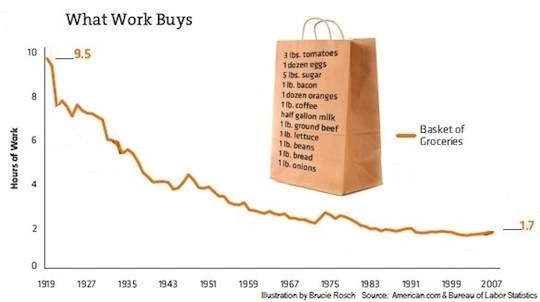
That’s a decrease of 82% in hours worked for groceries.
Why Is Our Food So Cheap?
Data from the Bureau of Labor Statistics shows that average food prices have dropped as much as 82% over the last century. What could possibly have caused such a dramatic change in real food prices? In short, food prices have fallen because the composition of our foods has been compromised by the industrialization of our food system.
Ham, which averaged (in 2013 dollars) about $5.90/LB a hundred years ago averages only $2.69/LB today.3 Doesn’t the fact that we now pay less than half the price that our great grandparents paid for “ham” seem to suggest that we’re possibly not eating what they ate? Taking a closer look at this example, it’s not hard to see that the very definition of “ham” has indeed changed significantly since the early 1900’s. Genetically modified Roundup Ready corn and soy laced with ractopamine is now fed to the pigs from which the ham is made. Huge 2,400-head confinement buildings house the pigs before they are taken to centralized slaughterhouses that kill them by the thousands. Ham recipes now include water, Sodium Phosphates, Carrageenan, Sodium Erythorbate, and Sodium Nitrite. I’d be willing to bet that your great grandmother would notice a significant difference between our 2013 “ham” and the hams that she ate that were cured by a trusted neighbor with salt and brown sugar. Simply put, the changes in the American food system that have enabled food prices to fall as much as 82% over the last century have, as an unintended consequence, altered the composition, lowered the quality, and decreased the healthfulness of our food. Let’s take a little walk through the last 100 years and see how this gradual change occurred.
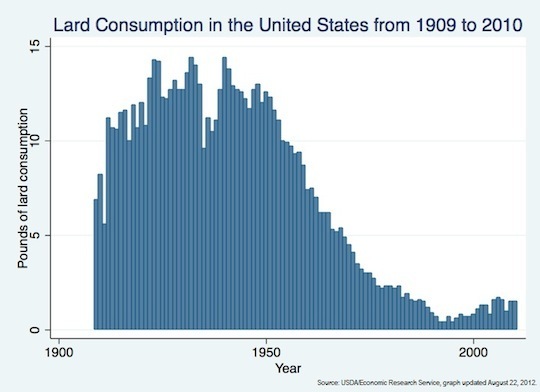
The effect of cheap margarine and Crisco on lard consumption in the US. Lard is now known to be one of the healthiest fats available to man, surpassing even olive oil in terms of healthy fat composition.
Beginning in the 1930s and 40s, increasing mechanization of food production and the advancement of food science technology started to change the American foodscape. At the turn of the 20th century a process was developed for the hydrogenation of liquid oils and by the 40s margarine had taken the place of butter and lard in many American homes. Chemical fertilizers became popular which, in conjunction with the advent of the self-propelled combine harvester, increased crop yields and lowered the prices of grains which eventually lead way to the feedlot model of beef production that we have today.
The signing of the Federal Aid Highway Act of 1956 enabled the construction of the Interstate Highway System which made national food distribution possible. This created a need for further advancements in food technology as Americans were, for the first time, buying huge amounts of foods from thousands of miles away. Preservatives were needed to keep foods tasting like they came from just down the street. National markets justified staggering investments in food processing equipment now that food companies could operate at a much larger scale. As the supply chain got longer, customers lost the direct ability to hold their farmers, butchers, and bakers accountable. Transparency of production was now a thing of the past.
Fierce competition between national food corporations arose which lead to price wars fought with cost cutting measures that often lead to lower quality ingredients. These cheaper ingredients didn’t taste like the real McCoy so food scientists concocted additives, dyes, and artificial flavorings to make up for the difference in taste and appearance. Companies found that product shelf life and margins could be increased by adding chemicals like BHT to packaging. Industrial food processing required processing aids like silicon dioxide to be added to spices to help them flow through the production line. The USDA did its part by allowing these additives to be treated as non-ingredients and therefore not requiring them to be listed on labels. Meat products were infused with water to reduce their price per pound and stabilizers were added to make up for the loss in texture.
Eventually international sourcing of foods became the norm because produce from Mexico, fish from China, and even grass fed beef from Tasmania was cheaper. With this development, even less accountability was possible and fears about food safety became the norm. Americans voted with their forks for cheaper food at any cost and prices continued to decline while rates of obesity, heart disease, cancer, and hypertension exploded.
You Get What You Pay For
This is where we find ourselves today. The effects of our modern food system touch nearly every part of this country from ecology to economics. But in short, we got exactly what we paid for: cheap food that wasn’t good for us. Food that wasn’t good for our rivers, our fields, our farmers, or our bodies. But this new “food” was indeed cheap. Very, very, cheap.
But there are alternatives. As I mentioned, Americans spend about 6.8% of their income on food. That is an anomaly from both a historical and a geographic perspective. In Portugal, most people spend twice that much on food. In France that figure is nearly at 13.5%. In both Japan and Italy, it’s more than 14.4%. And these countries are, in many other ways, quite comparable to the US.1 They just make eating good food a higher priority than we do and this choice is reflected directly in lower rates of obesity.4
You may say that you can’t afford those pastured eggs for $7.50/dozen at the farmers market. I’d be willing to bet that with your current lifestyle choices, that may be true. For some people, scraping together enough money to eat three solid meals of meats, eggs, and veggies of any kind at all is very difficult and after all it is much better to eat low quality meats, eggs, and veggies than Chef Boyardee. But for most of you reading this, there are choices you can make in other areas of your life that will make those delicious pasture raised orange-yolked eggs affordable. Do you really need two iPads? Would you be better off going on another vacation this year or staying home and spending that extra 5% of your salary on food that makes you feel good? We talk about the ancestral lifestyle rather than just the ancestral diet. Lifestyles are comprised of a series of choices that go far beyond not eating Frosted Flakes for breakfast. I can assure you that grass fed beef raised by American farmers who are struggling to survive in the modern marketplace will hands-down cost more than any other option you have. And it’s worth every last 2013 penny.
It’s up to you. You get what you pay for. As one Tendergrass farmer, Joel Salatin, puts it, “Have you priced cancer lately?” Joel may be blunt, but he makes a very good point. In the long run, cheap food might not actually be quite as cheap as we think.
David Maren is one of the founding farmers who created Tendergrass Farms , an online grass fed meat shop that makes it easy for you to support family farmers – one order at a time. He lives with his wife, Ann, and daughters Ruby Joy and Anna Claire in the Blue Ridge Mountains of Virginia. Please consider supporting Tendergrass Farms in their endeavor to sustain family farms by placing an order today at their online grass fed meats shop . For Mark’s Daily Apple readers, they’ve created a coupon code that’ll give you five (5) free one pound packs of their dry aged grass fed ground beef (a $49.95 value) with all orders over $199 which will also qualify your order for free shipping. Just head over to the Tendergrass Farms online grass fed meats store and toss $199 of their grass fed beef, pastured pork, pastured chicken, or pastured turkey into your cart. When you’re ready to check out just apply the coupon code WorthEveryPenny in order for five (5) pounds of dry aged grass fed ground beef to be miraculously added to your cart at a price of $0.00 (expires 10/15/13, limited to 50 redemptions, while supplies last).
1According to data from this Washington State University report
2Some would give higher estimates. That estimate came from Robb Wolf.
3The Bureau of Labor Statistics keeps records of US food prices over time in their Consumer Price Index. To calculate real prices I used their inflation calculator.
4The CIA has world obesity stats here.
Order The Primal Blueprint Starter Kit and Take Control of Your Health Today!

Mark Sisson's Blog
- Mark Sisson's profile
- 199 followers



